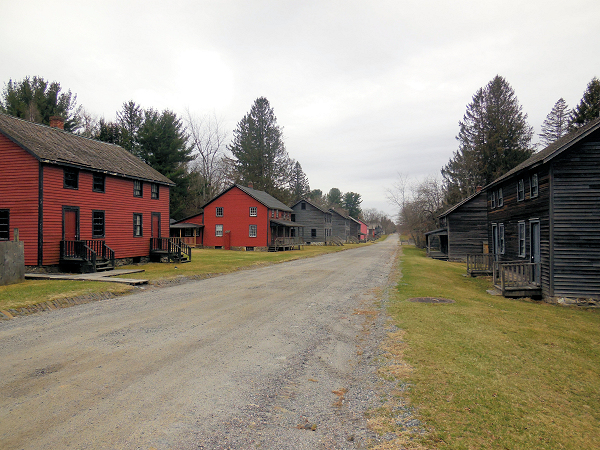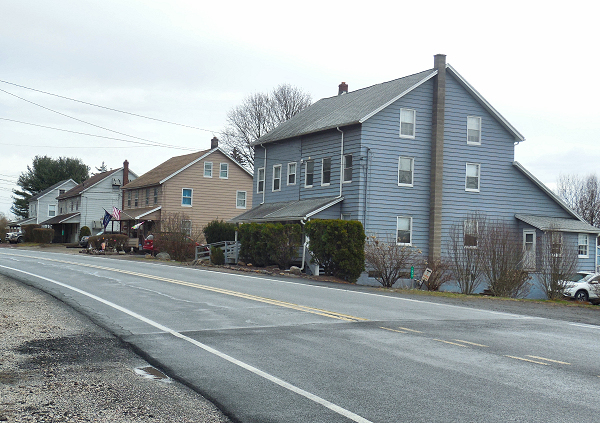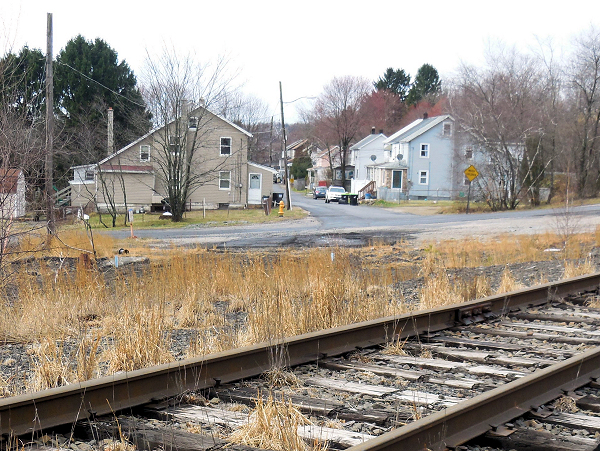EASTERN MIDDLE (LEHIGH) ANTHRACITE COALFIELD
Luzerne, Schuylkill, and Carbon Counties
Eckley, Pennsylvania
Sharpe, Leisenring and Company opened the colliery and company town at Eckley in 1854, although it was originally named Fillmore. This company
evolved into Sharp, Weiss & Co. Mining was originally in the Buck Mountain seam. In 1873, they operated two breakers and several portals for men, coal, and pumping mine water. As the 19th century went on, J. Leisenring & Co. operated the anthracite coal mines at Eckley, then Cross Creek Coal Co. By 1900, Coxe Brothers & Co. were the operators at Eckley. Under Coxe, the Wharton seam was also opened. The Coxe Brothers mined coal at
Eckley until 1940. The last operator of the Eckley mines and breaker was Jeddo-Highland Coal Co. There was also a Greenwood Coal Co. operating an Eckley No. 7 mine in the 1940s. The last time the Eckley
name appeared in state mining records was 1947. A Jeddo-Highland map for Eckley Colliery has its latest revision date as October 1949.
At that point, Eckley could look to the future through the same lens as other nearby "patch towns": Houses sold off to individuals, company store closing, breaker demolished, and many more decades of being surrounded by strip mining and endless remining of culm banks. But a funny thing happened in 1968. Film makers found the forlorn but intact village sitting at the eastern edge of the coal field to be an ideal setting for their movie about the Molly McGuires.
A replica breaker was constructed as a prop, as was a company store. The film, starring Sean Connery, was released in 1970. Shortly thereafter, the Pennsylvania Historical and Museum Commission became the owner of Eckley. A sign was put out on I-81, and a museum constructed at the end of town. Now the town is preserved and maintained as a tourist attraction.
Drifton, Pennsylvania
Coxe Brothers and Co. began mining at Drifton in 1865. An early name for the Drifton mine was Cross Creek Colliery. Later there were Drifton Colliery
No. 1 and No. 2. Coxe Brothers was somewhat progressive for a coal company of their era, and they made constant improvements in the Drifton mines. In 1879, Eckley Coxe (who actually lived at
Drifton) established a school at Drifton for men and boys to learn technical aspects of coal mining. Coxe Brothers built a hospital at Drifton in 1881, and an "iron breaker" in 1890. This long-lived
company mined anthracite coal at Drifton all the way until 1938. For the rest of the Drifton mines' life, it was leased to Jeddo Highland Coal Co., who operated it at least into the late 1940s. Also, Greenwood Mining Co. operated the
Drifton No. 9 mine simultaneously in the 1940s. Mining at Drifton was originally in the Buck Mountain seam. Later mining moved into the Mammoth and Wharton seams.
"Daniel Gallagher, boy, aged 12, was instantly
killed at Cross Creek colliery, April 12, 1877, by being crushed by the
breaker rollers. At the time of the occurrence the breaker men had gone
to the foot of the plane to put a car on the track, and during the interval
the boys got playing. The deceased went up to the second platform, and
by crossing the chute, which conveyed the coal to the 'Ponney rollers,'
his foot slipped, precipitating him into the rolls, and was not observed till
he was half way through the screen. The necessary preventive to obviate
such disaster had been neglected being put in its place when the men
left their work to put the car on the track. Owing to the demand for different sizes of coal, they had to remove or enlarge the hole leading into
the rolls, but in order to avoid any such accident, Mr. Coxe had strictly
forbidden boys being employed anywhere near exposed machinery,whereby
the same could not be fenced off."
Ebervale, Pennsylvania
Ebervale Coal Co. was mining Mammoth vein coal by 1864. Later they opened No. 2 and No. 3 mines. There were also No. 1 and No. 2 company
housing developments. In October 1872 the Ebervale breaker burned and had to be rebuilt. In February 1885, a fire broke out in Ebervale No. 2 slope and the fire spread up the slope to
the breaker. It was thought that a careless miner changing his cap wick started the 1885 fire. The fire did not consume the breaker this time. Ebervale mine was flooded by neighboring
Harleigh mine because an "outlaw" gangway had been driven that connected the two mines. This caused both mines to close. State mine reports noted, "The Ebervale employees have failed to get employment elsewhere this winter,
and if it was not for the-charity among the employes of this district, they would have suffered the pangs of hunger. In 1891 the five mile long Jeddo Tunnel was driven to drain these and other area mines. G.B. Markle and Co. became the operator of the newly
dewatered Ebervale Colliery. In 1903 Markle opened and additional portal, No. 4, and the Ebervale mines were electrified in 1904. G.B. Markle Co. also later opened mining into the Primrose Vein.
Primrose vein mining was exhausted on November 17, 1948, but Mammoth and Wharton vein mining continued later.
From 1894 to 1898 a New Ebervale Coal Co. existed for the purpose of "washing the culm from banks at Ebervale."
Harleigh, Pennsylvania
Harleigh Coal Company mined the 30' thick Mammoth vein of anthracite coal in the 1860s and 1870s on a lease from Big Black Creek
Improving Co. Slope No. 2 was opened in 1862 and Slope No. 3 in 1867. By 1875 there were two breakers and two slope portals at Harleigh. However, the Harleigh mine was poorly maintained and, in 1877, the mine caved in and entombed
two miners. McNair & Co. was listed as the operator of Harleigh in 1878. By 1885, the stream above the mines was inundating Harleigh, which also flooded the neighboring Ebervale
mine. The state ordered the operator to suspend operations, and Harleigh Colliery closed in 1886. After being idle for many years, G.B. Markle Co. reopened the Harleigh mine in 1907-08, including
a new breaker. In these years Jeddo Highland Coal Co. also built their Jeddo No. 7 breaker at Harleigh. In the 1910s, Harleigh Brookwood Coal Co. operated the Buck Mountain, Fish Tail, and Spear Point
slopes at Harleigh. By 1931, Harleigh Brookwood had closed the Harleigh mines and moved on to new coal reserves in Schuylkill County.
In later years, Harleigh was home to Jeddo-Highland Coal Co. No. 7.
Jeddo area patch towns
Four coal company towns existing in a row in Luzerne County: Oakdale, Middletown, Japan, and Jeddo. Jeddo was named for Yedo, Japan. Jeddo
mines No. 1 and 2 were opened in 1860/61 by the Jeddo Coal Co. However, these "patches" were best known as the home of Jeddo No. 4.
G.B. Markle & Co. operated it from the 1870s well into the 20th Century. Later, Jeddo-Highland Coal Co. operated No. 4.
Lattimer, Pennsylvania
The coal company later built an office building to the front left of this structure, which I failed to photograph.
Lattimer Colliery was opened by Pardee Bros. & Co. circa 1872 on a lease from Black Breek Improving Co. (The Pardee name features prominently in Hazleton area mining history, and
a company descended from the Pardee family's mining operations still exists in the 21st Century.) The Mammoth and Wharton veins were mined at Lattimer in the 1870s and '80s. In 1891, the Lattimer Mines
were connected with the new Jeddo Tunnel that drained water from area anthracite coal mines. There was more than one breaker at Lattimer. Some burned and were replaced, and others were rebuilt with more
modern technology. Later on, the Primrose and Gamma veins were also opened for extraction. In 1937, after at least 65 years of ownership by Pardee Bros. & Co., the new operator of Lattimer mines became Lattimer Coal Corp.
In additon to the deep mine, Lattimer Coal also stripped and remined the culm banks at Lattimer and cleaned other companies' coal in their breaker. This continued through World War II until Lattimer Coal sold the Lattimer operations to Hydrotated Anthracite Fuel Co. on September 1, 1947. (Lattimer Coal Co. continued to mine coal on the other side of Hazleton at the ancient Humboldt mines.) By 1953, Greenwood Mining Co. was operating the old Lattimer deep mines, which they finally wound down in 1954.
The hauting photo above shows a group of striking miners who had recently immigrated to Pennsylvania from Eastern Europe marching to Lattimer on September 10, 1897. One of them is obviously carrying an American flag as if to say, "We love America, too." It was probably also an appeal to the local populations to not judge them through the lens of ethnic prejudice. Apparently, the area had already been experiencing labor uprisings in the previous weeks due to
dissatisfaction with wages and working conditions. The march began at the Harwood patch town on the other side of Hazleton. Pardee Bros. & Co. became aware that the pro-union march was headed for their Lattimer operations. In a panic, they appealed to local law enforcement to assist in stopping the march. The sheriff and his henchmen ended up fatally shooting 19 of the unarmed strikers, many in the back. Many more were injured by the shooting, but survived.
A trial was held, and the sheriff and his deputies were acquitted of all charges, putting a stain on the justice system in Luzerne County that did not fade for many years.


April 2025 image by Author
Shown is the Beaver Brook, Pa. "patch town" and culm dump between McAdoo and Hazleton. In the 1800s, landowner French Coal Co. leased
the area to Beaver Brook Coal Co., who opened a mine and built a coal company town originally named Frenchtown. Frenchtown became known as Beaver Brook, and that is how
it is shown on maps. In 1875 Beaver Brook featured two breakers and multiple shafts into various anthracite seams. By 1878, the operator of Beaver Brook mines
was C.M. Dodson & Co. Dodson would continue to be the operator until well into the 20th century. Pardee Brothers and Co. operated the Beaver Brook underground mines in the 1930s,
and stripping operations began in 1934. The final closing of underground operations followed in the late '30s, followed by stripping by various companies over the years.

April 2025 image by author
A giant dragline sits behind the rail yard on the edge of Hazleton, Pennsylvania.

April 2025 image by author
A Reading & Northern coal train rolls through Hazleton.

April 2025 image by author
The label on the side of the Reading & Northern gondola cars reads, "America's Largest Anthracite Carrier."

April 2025 image by author
Anthracite coal mining began at Cranberry Colliery in the mid-1800s, and this operation would produce tremendous
tonnage over the years. By 1873, A. Pardee & Co. was mining the Mammoth and Wharton seams of coal at Cranberry, which
is located on the edge of Hazleton. The breaker burned in May 1879 and was replaced by a more modern jig breaker. A coal fire started in an underground pump station in the Wharton vein of the Cranberry mines on Oct. 8, 1897. It took
two days to extinguish, resulting in the death of two men and 16 mules. A. Pardee & Co. continued to operate Cranberry Colliery until the 1910s, at which point the operator became Cranberry Creek Coal Co. In the 1930s the
Cranberry mines and breaker were mined by Lehigh Navigation Coal Co. Stripping of the worked out sections of Cranberry by smaller operators began in 1932. In 1936, Cranberry Coal Co. took over from Lehigh Navigation.
Cranberry Coal Co., changed the name to Cranberry Improvement Co., and was still mining coal at Cranberry as late as the late 1940s.

1940 image, source forgotten
The Cranberry patch town and breaker near the end of the life of the mine. Also, coal mining at nearby Crystal Ridge patch was associated with Cranberry Colliery.

April 2025 image by author
Two churches in Beaver Meadows, Pennsylvania: The one on the left was St. Mary's Roman Catholic church that was supressed by the diocese in 2008;
and on the right is Saints Peter and Paul Byzantine Catholic Church.

April 2025 image by author
The replica breaker and coal cars built in 1968 at Eckley.

April 2025 image by author
Former Immaculate Conception Roman Catholic church and rectory. When it was built in 1861, the first parishioners were
mostly Irish Catholics. Several decades later they were probably Slavic. The church declined and became a mission church of another parish in the 1930s, and was finally closed in 1958.

April 2025 image by author
On the right is the former Episcopal church, and on the left are a few duplex company houses. One of them is still inhabited. I
was suprised to find permanent residents during my visit to Eckley. However, it doesn't suprise me that the Episcopal church is at the end of town where management lived.

April 2025 image by author
I could not find actual remaining buildings from the Eckley coal mines. However, this replica of a mule stable was built in 1987 on the site where a saw mill was located.

April 2025 image by author
Duplex company houses lining both sides of Eckley's main street. This style of two-family house is known as the Pennsylvania Miners' House, and is synonymous
with Pennsylvania coal towns in both the anthracite and bituminous fields. When veterans of the coal industry went south in search of new coal fields, they still at times built this style of house in their new
company towns, such as Barrackville and Gary, W.Va.

April 2025 image by author
Many of the outhouses (called "privies" in Pennsylvania) and sheds that were erected over the years are still in place.

April 2025 image by author
Eckley single family company houses. There was once a parallel street of company houses called South Street. These houses were gradually
demolished in the 1930s, '40s and '50s and the area was strip mined. Today, only a remnant of South Street remains.

April 2025 image by author
The Eckley breaker as viewed from the residential area.

April 2025 image by author
The styles of front porches vary at Eckley from shared porch for the entire house, such as this example, to twin uncovered stoops.

April 2025 image by author
The mine owner's house was and is the nicest home at Eckley.

April 2025 image by author

April 2025 image by author
Coal ash buckets that have been set out for the garbage man. The Drifton "patch" is in the background.

April 2025 image by author
Former company houses.

April 2025 image by author
Houses on Coal Miner Drive. Another street is named after Sophia Coxe.

April 2025 image by author
Saint James Episcopal Church.

April 2025 image by author
In a front yard I found what looked like a tribute to Drifton's industrial past.

Architectural drawing of the hospital for injured coal miners that Coxe Brothers constructed
at Drifton in 1881.

April 2025 image by author
Ebervale coal company houses.

April 2025 image by author
This area on the edge of Ebervale shows a modern breaker in the background. The detritus from over 150 years of mining
is not uncommon in the anthracite coal fields.

April 2025 image by author
The old engine house remains from the Ebervale mines.

April 2025 image by author
Also, this mine fan was probably installed by G.B. Markle Co. In the background are culm banks and strip mines.

April 2025 image by author
The engine house with Ebervale No. 1 "patch town" in the background.

April 2025 image by author
A closer look at these "salt box" coal company houses.

April 2025 image by author
A memorial to the community's veterans in ubiquitous to Pennsylvania's coal company towns. But they all don't feature a large chuck of coal like this one.

April 2025 image by author
A yard locomotive decays at the edge of Ebervale.

April 2025 image by author

April 2025 image by author
Harleigh coal company houses with mountains of coal or culm in the background.

April 2025 image by author
Active and post-mining coal lands are adjacent to Harleigh.

April 2025 image by author
Harleigh "patch town."

April 2025 image by author
Area where the Harleigh Breaker used to exist.

April 2025 image by author
Multi-family coal company houses.

April 2025 image by author
The city of Hazleton, Pa. can be seen in the background behind Harleigh.

April 2025 image by author
Duplex houses in the Middletown patch. Beyond this would be Oakdale patch.

April 2025 image by author
Back yards at Middletown. Another patch, which was located just to the south, was completely removed in the 1950s or 60s.

April 2025 image by author
The front of a row of Middletown houses with distinctive roof pitches.

April 2025 image by author
Barracks-style coal company housing at the Japan patch.

April 2025 image by author
This part of Jeddo was originally known as Pink Ash.

April 2025 image by author
Looking through Jeddo toward Hazleton.

April 2025 image by author
Former company store at Lattimer Mines, Pa. On the left was a meat market, on the right was the company offices,
and in the middle was the company store. At the time of this photo, the building housed the Lattimer post office and a dog grooming business.

April 2025 image by author
Some of the remaining coal company "patch" houses at Lattimer.

Pennsylvania State Archives image
Alas, Lattimer won't be remembered for being one of the most productive mining operations in the Hazleton area (which it was), but for being the location of an organized labor tragedy.